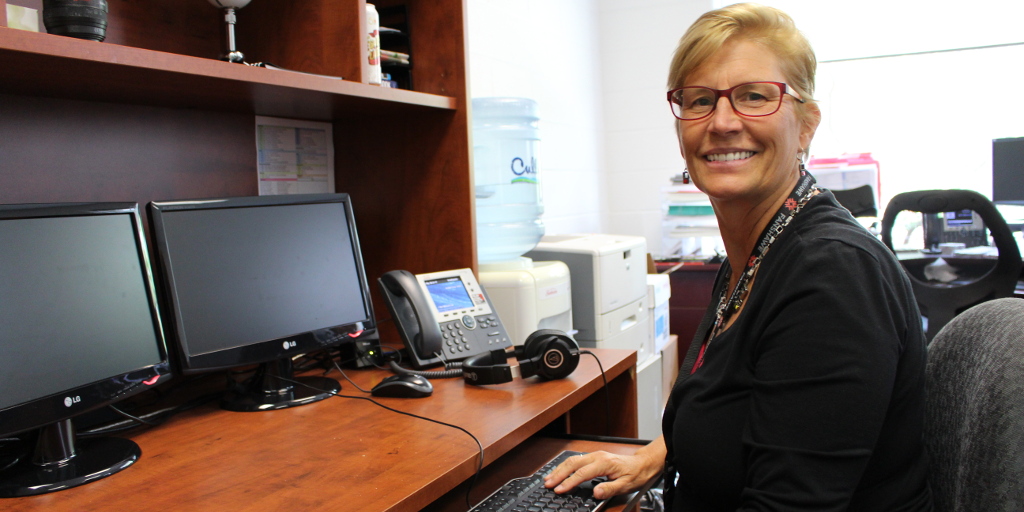Ergonomics expert Allison Stephens comes to Fanshawe to teach the next generation of ergonomists
 CREDIT: JEN DOEDE
CREDIT: JEN DOEDEAllison Stephens, the new co-ordinator for the advanced ergonomic studies program in Fanshawe's School of Public Safety is excited to return to Canada and work with the Fanshawe community.
Renowned ergonomist Allison Stephens accepted the position as co-ordinator for the advanced ergonomic studies program in Fanshawe College’s School of Public Safety.
Ergonomics is the scientific study focusing on the level of efficiency and comfort that exists between individuals and their workplaces.
Mark Hunter, the chair of Fanshawe’s School of Public Safety, explained that the advanced ergonomic studies program at the College is the first of its kind in Canada.
The program, which launched in 2016, consists of a 15-week academic semester followed by an 8-week field placement.
According to Stephens, the field placement will give students the opportunity to learn about the different aspects of ergonomics, while being overseen by a professional ergonomist.
“Allison Stephens is nationally and internationally recognized as a leader in the field of ergonomics. Our students are going to immensely benefit from having her as a professor and a co-ordinator in our advance ergonomic studies program,” Hunter said.
Stephens stated that she is very excited to come back to Canada and empower students with the skill set they need to become future ergonomists.
“I’m really excited to be part of this community. I think that Fanshawe has grown as much as I have grown while I’ve been away and it’s exciting to come back and see the transformation of the campus,”
Stephens said. Stephens has recently retired after working for 31 years at the Ford Motor Company in Dearborn Michigan. Stephens explained that she started her career at the St. Thomas Assembly, which was one of Ford’s automotive manufacturing locations.
At the assembly line, Stephens was part of the health and safety team and was responsible for conducting accident investigations.
Stephens explained that in order to prevent the same injury from happening again at the workplace, the team would make modifications to work stations. For example, instead of having employees pickup heavy parts from the floor, causing back injuries, a lift table or raiser would be added to elevate the parts.
Due to Stephens and her ergonomics team’s work at Ford, the location saw an almost 80 percent reduction in injury rates over the five years she’d been employed.
Ford Motor Company took notice of Stephens’ achievements and offered her the opportunity to bring the ergonomics program to the North American headquarters in 1991.
Stephens accepted the offer and started working in Dearborn, MI. There, she travelled to plants all over North America to instruct facilities on how to set up an ergonomics team and how to effectively investigate accidents.
Eventually, Stephens was transferred from the health and safety department to the engineering department.
Part of the engineering team’s responsibilities was to design the equipment and work space based on accident prevention information.
Eventually, the assembly line started implementing virtual technology into the engineering program and as a result, designs were created in computer-aided design programs (CADs) using 3D modeling techniques.
With the influx of virtual technology innovating the engineering sector of the Ford Motor Company, Stephens got into an area called digital human modeling.
The team would use an AutoCAD to create a human model that could be inserted into the prospective designs. This simulation could replicate the actions of employees and revel any flaws.
Stephens would also do a biomechanical analysis to determine if an action would be too strenuous for an operator.
“I built a virtual lab for Ford Motor Company and we worked with our engineering community to make all work stations go through a virtual assessment using motion capture and digital human modeling,” Stephens said. “It worked so well we actually reduced the number of prototype vehicles that we had to build, which saved us millions of dollars. We were also able to deliver our plans faster to market.”
Stephens also had the opportunity to travel to countries such as China to educate engineers on ergonomics, in addition to receiving numerous awards such as the Henry Ford Technical Award.
According to a Fanshawe Corporate Communications news release, Stephens has been published more than 20 times for her work in the field of ergonomics.
Stephens began her new adventure at Fanshawe on September 1 and has positive thoughts to say about it.
“I’m really excited to be here and have Fanshawe as the next think pod to where we are going to go in the field of ergonomics,” Stephens said.














